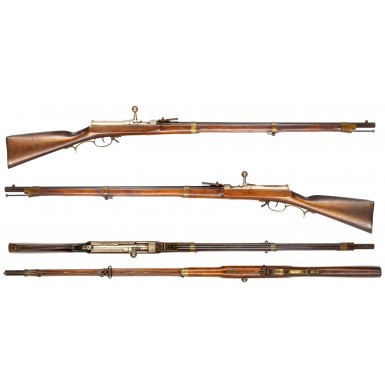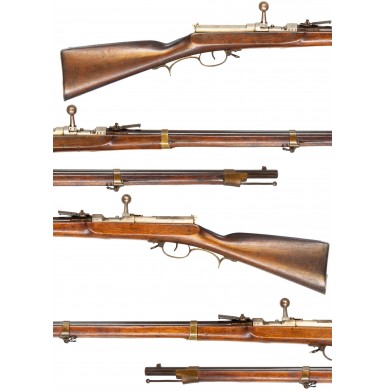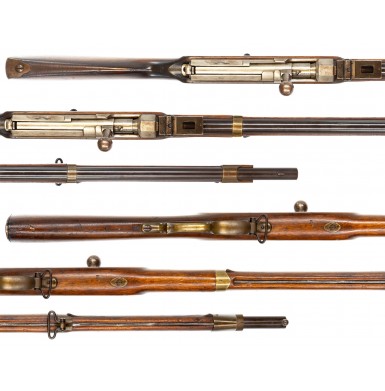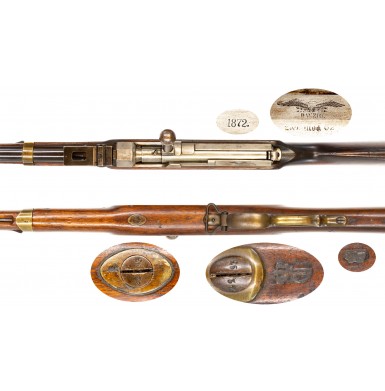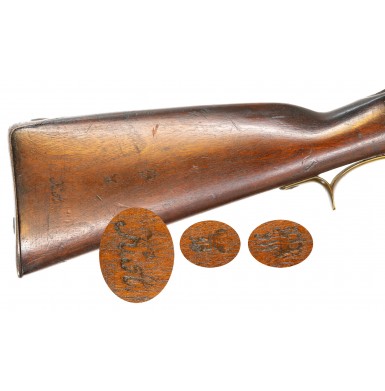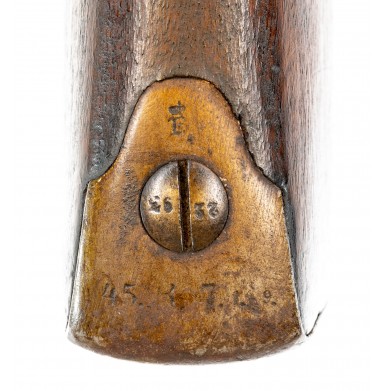Rare and Fine Prussian Model 1862 Dreyse Needle Rifle
- Product Code: FLA-3992-SOLD
- Availability: Out Of Stock
-
$3,995.00
In 1836 Johann Nikolaus Dreyse, who was later honored with a title making him Johann Nikolaus von Dreyse, revolutionized the world of military firearms by submitting his bolt action “needle rifle” to the Prussian military for testing and trials. Dreyse had been born in Sömmerda, Prussia in 1787, and probably developed an interest in making and building things from his father, who was a blacksmith. From 1809-1814 Dreyse worked for the famous Swiss gunmaker Jean-Samuel Pauly, who operated a gun manufactory in Paris. It was there that Dreyse was probably exposed to the concept of breechloading rifles, as Pauly conducted a number of experiments during that time of various breechloading designs. Dreyse returned to Prussia after working for Pauly and established a percussion cap manufactory in Sömmerda in 1824. Dreyse was certainly on the cutting edge of the firearms business at the time, as the percussion cap was still nearly two decades from somewhat universal, worldwide acceptance. It was at this time that Dreyse started to experiment with self-contained paper cartridges. While paper cartridges that contained black powder and projectiles had been around for almost two centuries, they all required the use of an external ignition system, either powder in the pan of a flintlock or a percussion cap on the cone (nipple) of the gun. Dreyse developed a paper cartridge that contained not only the bullet and the powder, but also the percussion cap, which was situated at the bottom of the bullet, forward of the powder charge. Placing the cap in that location allowed the base of the bullet to act as the anvil upon which the cap could be detonated when it was struck. Dreyse also developed a long, needle-like pin that was tensioned by a coil spring and was effectively the first widely produced firing pin design.
Initially Dreyse applied these new developments to a muzzle loading firearm design, with the novelty being the self-contained paper cartridge and the needle fire ignition system. This did not, however, provide significant advantages over conventional percussion muzzle loading arms. He then applied the concepts to a faucet action, breechloading design but the very nature of the small lever-actuated chamber meant that the cartridge was rather anemic. The faucet breech action was primarily confined handguns and small caliber, low power rifles similar to the English “Rook Rifle”.
In 1836 Dreyse combined his ammunition and needle fire striker system with his newly designed breechloading rifle that was bolt actuated. This was revolutionary, as it made the gun very fast to load and allowed it to be easily loaded while the shooter was prone, concealed or even on horseback. The bolt action system allowed for a larger, more powerful cartridge than would fit in the faucet breech firearms. He submitted his design to the Prussian military, and it was accepted in December of 1840. In 1841 the new infantry rifle was designated the Leichte Perscussions-Gewehr M1841. The name “Light Percussion Rifle M1841” was meant to conceal the revolutionary nature of the new firearm, but by 1855 the term Zündnadelgewehr (Needle Gun) was in general use within the Prussian military. The rifle was a 15.4mm (about .61 caliber), single shot, bolt-action breechloader that looked rather like the previous generations of Prussian muzzleloading flintlock and percussion muskets. In fact, at first glance the Model 1841 looked rather like a bolt action version of the Model 1809 “Potsdam” musket and the Model 1839 musket that had superseded it, as it retained the same style of beech stock, brass barrel bands and general silhouette of the earlier muskets. In place of the usual percussion lock there was only a stock flat, reminiscent of the counterpane of a percussion musket. The new Model 1841 was somewhat shorter and lighter than its percussion predecessor with a 33 ½” barrel and a 54” overall length, while the Model 1809 had a 41 ¼” barrel and was 56 ½” in overall length. The new rifle could fire 10 to 12 rounds per minute, which was an astounding rate of fire for the time. The muzzle velocity was about 1,000 ft/s and the rifle had an effective range of about 600 yards. While this was somewhat shy of the 1,000 yards that the best muzzle loading rifle musket designs of the mid-19th century were capable of, the rapidity of fire more than offset any advantage in long range accuracy that a muzzleloading firearm might have possessed. The primary issue affecting the long-range shootability was inefficient gas sealing at the breech, which allowed the escape of gasses at that location and reducing the chamber presser and projectile velocity. The other major drawback was the fact that the firing needle had to be very long to reach the primer deep within the paper cartridge, at the base of the projectile. This led to issues with needle breakage and required that the soldiers to carry spare needles with them, as well as to be capable of disassembling the bolt system in the field to replace a broken needle. In an attempt to improve the quality of the Model 1841, and potentially reduced gas leakage, a new version, the Model 1862, was adopted in that year.
The M1862 retained the 15.4mm caliber, broad 4-groove rifling and the needle fire bolt-action system but was produced with improved tolerances in an attempt to limit leakage and improve interchangeability. The new rifle also had a slightly shorter, 32 ½” barrel and the “short butt variant” was only 52 ¾” in overall length. However, the improved version was only slightly better in terms of gas leakage. Despite the short comings of limited range, gas leakage and needle durability, the amazing rate of fire made the Zündnadelgewehr a fearsome weapon to be encountered by an enemy armed with conventional muzzle loading muskets. The Prussians used the Zündnadelgewehr (both M41s and M62s) with devastating effectiveness against the Austrian infantry during the Austro-Prussian War of 1866, where observers commented on the fact that a prone Prussian infantryman could fire 5 rounds in the time it took a standing Austrian infantryman to load his rifle one time. During the Franco-Prussian War (1870-1871) the superiority of the smaller caliber French Model 1866 Chassepot Rifle with its obturating bolt was quickly obvious to the Prussian military. The Chassepot’s bullet was fired at a higher pressure with less gas leakage, resulting in greater velocity and range. Thus, a system of modification of existing stocks M41 and M62 rifles began. The alteration, known as the Beck Conversion, required that a new bolt head be installed on the face of the bolt. This new bolt head was attached with a large screw through the side of the bolt, which is easily visible from the exterior. Additionally, a leather washer was placed between the new bolt head and bolt body, creating an obturator. When the rifle was fired the gas pressure pushed the new bolt head back and expanded the leather washer against the chamber walls, increasing the gas seal, similar to the obturator found in the French Chassepot rifle. This reduced leakage and increased bullet velocity. The Beck system also used modified ammunition with the bullet seated deeper in the papier-mâché sabot, allowing the use of a slightly shorter needle. Nearly every needle rifle found today has the Beck Conversion to the bolt.
The end of the Franco-Prussian was quickly followed by the adoption of the new Mauser designed M71 bolt action rifle, the first self-contained metallic cartridge rifle to be adopted by the Prussian military. As a result, the M41 and M62 needle rifles were quickly relegated to secondary service with the Landwehr (German secondary reserve troops or militia) and was wholly obsolete very quickly. However, the Zündnadelgewehr was a groundbreaking weapon that served Prussia’s front-line troops for three decades and remains the first bolt action rifle to see universal issue to the military of any country.
Offered here is a wonderful example of a Infanterie-Gewehr M 1862, or a M62 Zündnadelgewehr (Model 1862 Needle Rifle). The rifle remains in VERY FINE overall condition and is all complete and correct except for the fragile needle, which is often missing or broken and the leather obturating washer. Additionally, the cocking piece, while an original period one, is also not numbered to the gun. The rifle was manufactured at the Prussian national arsenal at Danzig and is marked with the {Spread-Winged Eagle} of King Wilhelm I on the upper left angled flat of the receiver, over the word DANZIG. The Prussian national arms manufactory in Danzig was known simply as the Danzig Arsenal at the time. Danzig was the German name for the Polish city of Gdansk. The city changed hands and “nationalities” on a regular basis for most of its history. While it had been established as Polish city late in the 10th century, it was soon under the control of the Piast state. The city was again part of Poland from 1454-1793, and after that was not restored to Polish rule until the conclusion of World War II. During its history it was under “German” control for most of its existence, being ruled by the Teutonic Knights from 1308-1454, the Kingdom of Prussia from 1793-1806, and again from 1815-1919. Danzig was made a “free city” after the conclusion of World War I but was invaded by the Nazis in 1939 and brought under German control until 1945, with the city returning to Polish rule that year. The arsenal in Gdansk (Danzig) dates to the early 1600s and is a classic example Mannerist architecture and remains a popular tourist attraction today, even though it is a reconstruction of the original arsenal, which was destroyed during World War II.
On the left flat, below the arsenal mark is the model B G Mod:62 in Germanic script, which indicates that this is the Infantry Rifle Model 1862, known colloquially as the Zündnadelgewehr or “needle rifle”. The upper angled receiver flat on the right side is marked with the year of manufacture, 1872. The rifle is serial number 2293, and the full serial number is present on the left forward portion of the receiver and on the left reward portion of the barrel where it meets the receiver. The barrel additionally bare a {CROWN} / FW proof mark on the left side and is marked Stahl (steel) on top. The full serial number appears on almost every piece of iron or steel on the rifle including all of the furniture screw heads. As noted, the cock piece is mismatched and is numbered 8933. The brass furniture (barrel bands and triggerguard) are not numbered, but all bear Prussian inspection marks. The top of the iron buttplate is unit marked and appears to read 45. R. 7. 1.49., indicating that the rifle was issued to the 45th Infantry Regiment, 7th Company, Weapon Number 149. This 45thdesignation indicates that rifle was issued to the 8th East Prussian Infantry regiment, No. 45, which was assigned to the 4thBrigade of the 2nd Infantry Division of the I Army Corps during the Franco-Prussian War. The I Corps was commanded by General der Kavallerie Edwin Freiherr von Manteuffel who had served gallantly during the Austro-Prussian War in 1866 and received the order Pour le Mérite (the “Blue Max”) for his service during that war. During the Franco-Prussian War his leadership won a number of major victories for the Prussians, and he received the Order of the Red Eagle during that conflict. He was promoted to Field Marshal at the conclusion of the war and was appointed the Imperial-Lieutenant (essentially governor) of the recently acquired French Alsace-Lorraine region.
A plethora of Prussian inspection and proof marks are clearly stamped on the right side of the receiver and barrel. Numerous inspection marks are present in the stock as well, both underneath and on the obverse butt. In addition to the {CROWN} / FW and inspection marks, the butt is also marked K A in script, indicating “Kurze Anschlag” or “short butt”. The longer butt version is marked “LA” for “long butt”. The rifle retains about 90%+ of its original browned finish on the barrel, which shows some thinning, fading, and dulling and has oxidized lightly in some areas. The receiver and buttplate remain “in the white”, but both show evenly scattered surface oxidation and discoloration, the buttplate in particular. These areas of have been lightly cleaned in the past, leaving some of the receiver markings somewhat weak. The metal of the rifle remains almost entirely smooth, with only some very lightly scattered minor pinpricking here and there along the length of the barrel and around the receiver. Some more moderate pinpricking is present around the hexagonal chamber of the receiver, at the muzzle and on the buttplate which also shows a moderately oxidized brown patina. The bore of the rifle is in VERY FINE condition, and remains extremely bright over most of its length, with extremely crisp four-groove rifling. There is only some lightly scattered oxidation and discoloration along the length of bore, along with some minor light pitting and some frosting in the grooves. The bolt action mechanism functions correctly, as does the cocking mechanism. The bolt shows the Beck bolt face conversion that nearly all Zündnadelgewehrsunderwent during the late 1860s and early 1870s in an attempt to improve the gas sealing properties of the design. As noted earlier, the only condition issue worth noting in the mechanism is the absence of the needle, and the leather bolt washer. However, replacement needles are available. The rifle retains its original rear sight with the fixed block, small folding leaf, and long range adjustable folding leaf. The sight retains most of its original blued finish, mixed with a moderately oxidized smoky gray patina. The original front sight/bayonet lug is present as well. The original cleaning rod is present in the channel under barrel and appears to be full length but is tightly secured in the channel and I could not remove it from the stock. The rod is slightly bent at the end. The brass furniture has a wonderful, untouched dark patina with some greenish-brown tones and like the balance of the rifle shows no indication of having been cleaned. The original upper sling swivel is in place on the middle barrel band, but the lower swivel is missing from the triggerguard bow. The stock of the rifle is in about FINE overall condition. The stock was apparently lightly cleaned at some point and left the inspection marks very lightly smeared. Some surface scuffs are present on the wood as well, but the edge remain strong and relatively sharps. The wear and the condition of the stock match the rifle perfectly. As would be expected, the stock shows the usual assortment of scattered bumps, dings, scuffs, and surface mars that any 19th century military rifle would have.
Overall, the rifle remains in extremely fine condition and is a wonderful example of the type of arms carried by front-line Germanic states infantryman during the Franco-Prussian War. The rifle is nicely unit marked on the butt to a unit that served with distinction during the Franco-Prussian War. The rifle was made during the very end of needle rifle production at a time when the new Model 1871 Mauser rifle had recently been adopted and would soon replace it. The rifle is very attractive and displays wonderfully. It would make a wonderful addition to any serious collection of Prussian military arms, Franco-Prussian War period weapons or even a collection of German military rifles, as the Zündnadelgewehr was the first “modern”, bolt action rifle to see service with German military units. This is a rifle you will certainly be very proud to own and to add to your collection.
SOLD
Tags: Rare, and, Fine, Prussian, Model, 1862, Dreyse, Needle, Rifle


